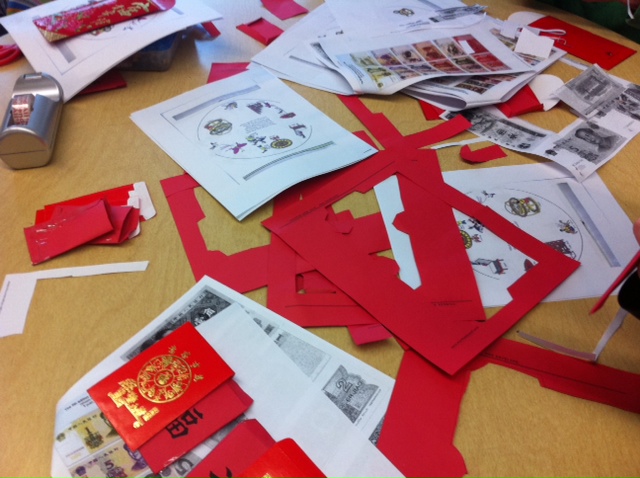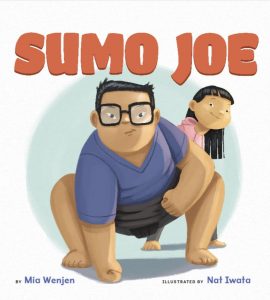My mom friend Stella who is Chinese explains the ins and outs of Chinese Red Envelope etiquette and its significance to 2nd grade kids. We did a special presentation as part of their 2nd grade China Unit that included: the Chinese invention of paper money, red envelope craft and background, Chinese silk children’s clothes, and Chinese money. It was a lot of fun!
Chinese Red Envelope Facts and Trivia
Red envelopes are used to give gifts of money. When I was a little kid, I would get red envelopes from older relatives on holidays, my birthday, or if I hadn’t seen someone for a long time. When I got older, I also got red envelopes when I graduated from school, when I got married, and even when my grandfather passed away.
For Chinese New Year, only married people give red envelopes away to children and young single people (one of the downsides of getting married!). The more money you give away, the more luck you will have for the new year.
Chinese are very superstitious. Even numbers are thought to be better luck than odd numbers so for better luck, a person would give someone two red envelopes instead of one. 4 is a bad luck number so you never want to give amounts of 4 like $4, $40, $44, and so on. The number four in Chinese sounds like the word for die/death. What’s another example of a bad luck amount??
8 is the luckiest number so if you want to give someone $8 you would put $5 in one envelope and $3 in another or whatever combination you like but not $4 and $4! The number 8 in Chinese sounds like the word for wealthy.
The color red is for good luck and so the envelopes are red. When a bride gets married, she wears a red silk dress and not white. For Chinese New Year, everyone wears a new red outfit usually made of silk. When someone gives you a red envelope, you should take it with two hands and not one. This is the polite way of doing it and you should never never open the envelope in front of someone. That would be very bad manners. Also, never put old wrinkled bills in a red envelope. People never write their names on the outside of red envelopes so you have to remember who gave you which envelope!
There are Chinese characters on the outside of red envelopes. On wedding red envelopes you might see the symbol of double happiness. On the template that the children are doing, it says Food=Luck. A friend of mine translated it for me. Having food is so important since most Chinese have the bare minimum of food (back in the old days – pre-open capitalism).
This is the printable Chinese Red Envelope craft from Martha Stewart. We combined this craft with the printout of Chinese money.
The Chinese Invented Paper Money! (And a lot of other things!)
I used to pull this information from Computer Smiths for the 2nd grade China Unit to cover the invention of paper money:
The Song dynasty was the first to issue true paper money in 1023, and it did so at first cautiously, issuing small amounts, used in a limited area, and good for a specific time period.
The most famous Chinese issuer of paper money was Kublai Khan, the Mongol who ruled the Chinese empire in the 13th century. Kublai Khan established currency credibility by decreeing that his paper money must be accepted by traders on pain of death. As further enforcement of his mandate, he confiscated all gold and silver, even if it was brought in by foreign traders. By the 15th century, even China had more or less given up paper money.
Over this period, paper notes were issued irresponsibly, to the point that their value rapidly depreciated and inflation soared. Then beginning in 1455, the use of paper money in China disappeared for several hundred years. This was still many years before paper currency would reappear in Europe, and three centuries before it was considered common.
The Greatest Power by Demi has a two-page spread that includes some of the inventions by the Chinese. It’s a great story with beautiful illustrations.
We used these links to print out Chinese money for the kids to play with. They cut it out and used it for the Red Envelopes. They even remembered not to put in money that adds to the number four. You could play additional games with the money:
Match the front to the back as a match game.
Figure out how to make the money add up to the number 8 but avoid the number 4. So 8 is good. 18 works too. 28 is fine. But 24 is bad!
Silk is Another Chinese Invention (and Boys Love to Dress Up in Chinese Robes!)
Who knew that the boys would be so eager to dress up?! I think it’s because the Chinese silk dressing robes reminded them of boxers in a ring. I only caught that connection when two boys, enrobed in silk, tried to spar each other. I had to put a stop to that. A mom friend Melissa brought in these lovely clothes. It was a big hit with the kids!

Chinese Classic Dance
The 2nd graders had an earlier field trip to the local Chinese Cultural Center where they made and ate dumplings, played with Chinese Yo Yos, and watched Chinese Traditional Dance. If you don’t have that kind of resource, I found a video that covers Chinese Dance. They do a show in town but watch up to minute 9, the rest of the video is anti-Communist propaganda which the kids won’t really understand.
Grasshopper and Sensei painted this for her Chinese New Year party in Middle School.
p.s. Here are a few more Chinese New Year posts.
Chinese New Year Crafts and Activities for Kids
Chinese New Year Books for Kids
Lion Dances for Lunar New Year in Boston’s Chinatown
To examine any book more closely at Amazon, please click on image of book.
As an Amazon Associate, I earn from qualifying purchases.
Follow PragmaticMom’s board Multicultural Books for Kids on Pinterest.
Follow PragmaticMom’s board Children’s Book Activities on Pinterest.
My books:
Food for the Future: Sustainable Farms Around the World
- Junior Library Guild Gold selection
- Selected as one of 100 Outstanding Picture Books of 2023 by dPICTUS and featured at the Bologna Children’s Book Fair
- Starred review from School Library Journal
- Chicago Library’s Best of the Best
- Imagination Soup’s 35 Best Nonfiction Books of 2023 for Kids
Amazon / Barefoot Books / Signed or Inscribed by Me



















So interesting. I’d heard of the red envelopes before, but not all the details involved – especially accepting it/them with two hands and not opening them in front of the person.
Hi Elle,
I’m half-Chinese and I didn’t know about the details either!
I have also heard of red envelopes from my Chinese students, but I never knew all the details. This is a fascinating post…loved the history of paper money. This lesson should not be limited to second and third graders!
Thanks so much Barbara! I learned so much myself about the red envelope tradition which is weird since I’m half Chinese!!
The classical dance video is incredible! I pinned this to my global learning board – great post!
Hi MaryAnne,
I’m not sure if you’ve seen them perform but they come to Boston every Feb for a Chinese New Year performance at the Opera House. We saw them a few years ago. I agree with you — the Chinese classical dance is amazing. It turns out that it’s the basis for modern gymnastics too! It’s so interesting to me to find Chinese influence where you least expect it.
Oh, that explains a lot! I was watching it and thinking how much it looked like rhythmic gymnastics!
Very interesting. I knew about the Red Envelope but no all the details. Regarding the bad number 4, recently a an area in Toronto decided to to have houses with the street number of 4. Chinese Dancing fro young and old is so beautiful and elegant.
Hi Giora,
That is so funny that they want to have street numbers of 4 in Toronto since it has a high Chinese population. I was new to the details of the Red Envelope too. I only knew that you got them for holidays and they had money in them. My parents didn’t really celebrate it but family friends did. I hope I never opened them up in front of people though! Did not know that one!
Sorry, I made a typo. They decided to have streets WITHOUT the number 4. And yes, we do have a large Chinese population here, about 500,000. Have a great weekend.
Hi Giora,
Ah, that makes sense! I can see why the Chinese would avoid streets and house numbers with the number 4. In California, they build tract houses with Feng Shei principles to help the houses sell better. It seems to work, I hear, especially with the Asian buyer.
The Demi book looks great!
Also I don’t feel so crazy now with my preference for even numbers!
Thanks for linking to Worldwide Culture Swapper! I learned a lot from this post about Chinese good luck/bad luck numbers and can’t wait to share with my daughter. We are also doing a Chinese unit right now at home.
Hi Natalie,
Thanks so much for your kind comment! I’m glad you liked it. I’m half Chinese and I really had no idea about the traditions behind the red envelope either LOL! Kids really do like the Red Envelope craft and tradition and I can see why!
This is such a great overview and wonderful activities! That would be hard to remember who gave you which red envelope! Just a note – when my sister studied in Beijing years ago, if I remember correctly there was special money just for foreigners to use. And I remember that the faces shown on the money were of the many minority groups in China. Is that right? Thanks for sharing at the Culture Swapper!
Hi Leanna,
YES! I remember getting special Foreigner Money when I visited China 30 years ago. I don’t remember getting so many Red Envelopes as a child as to be confused who they were from but that would be a nice problem to have!! LOL! I do remember that they were a special treat and I think I tore them open. Hmmm… my etiquette was not up to par! Thanks for hosting the Culture Swapper!
Hello! Thank you so much for linking up at the Creative Kids Culture Blog Hop#9! I had a Chinese student come to my house for a Chinese New Year cultural playdate for my son, and his friends and she talked about the red envelopes; and strangely enough I gave her a card (as a thank you for her time, and effort) but she didn’t open it up right away. She later then told me that it wasn’t customary to open it up in front of me, and she apologized. I told her not to worry about it.
Thanks so much Frances! I didn’t realize either that you are not supposed to open the red envelopes right away (and I’m half Chinese!!!).